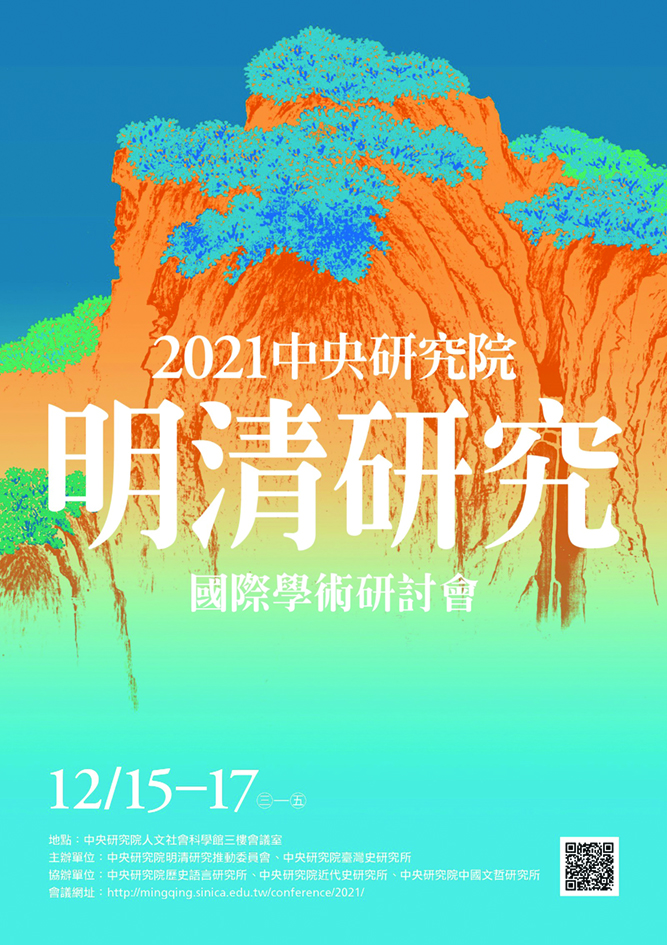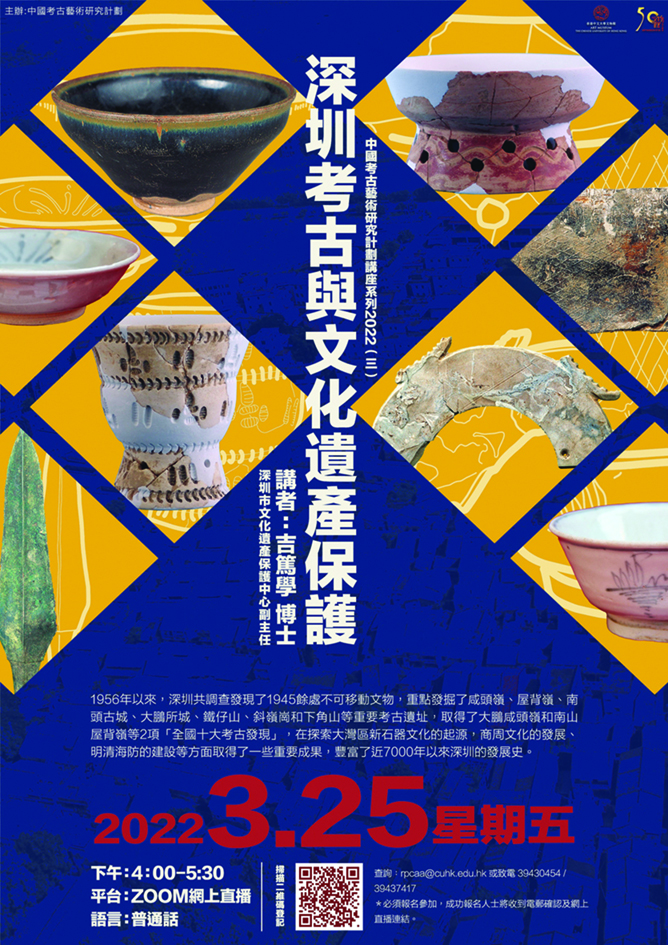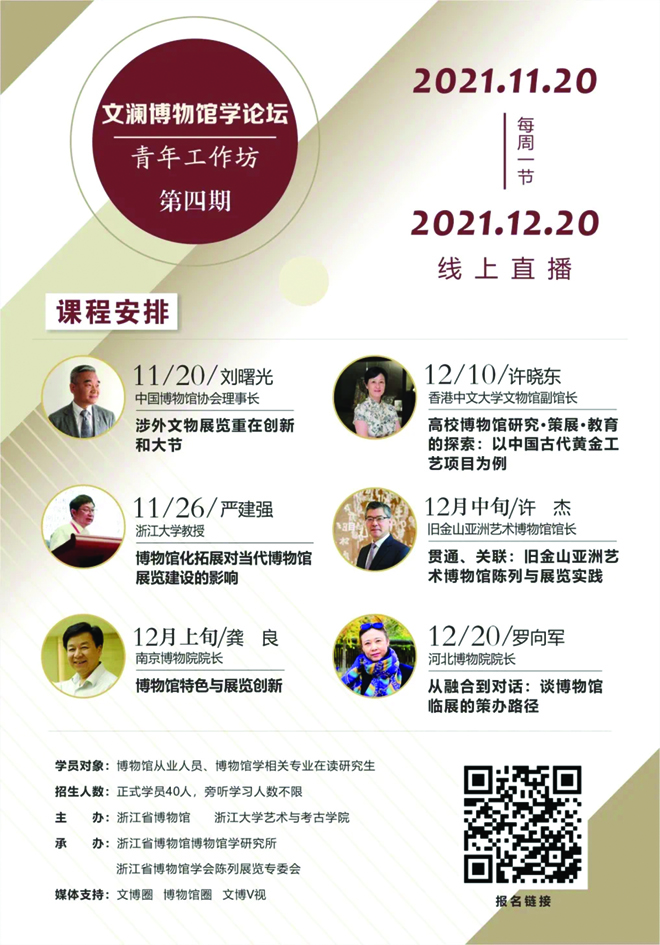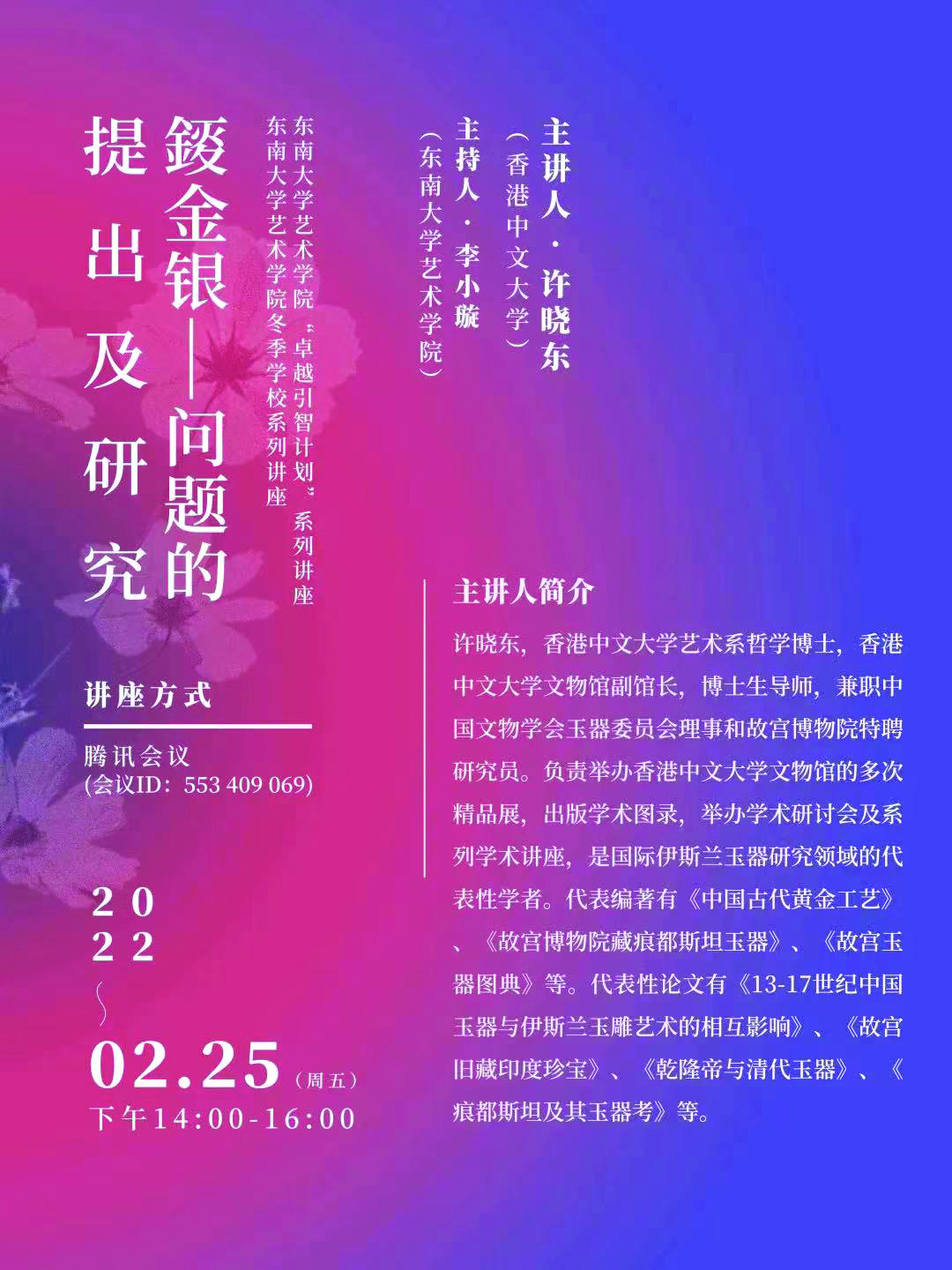RPCAA Lecture Series
The “Research Programme for Chinese Archaeology and Art” of the Art Museum attaches considerable importance to promoting academic exchanges and stimulating public interests in ancient culture.
Our Programme has started a regular lecture series since February 2021, on the last Friday of each month, from 4:00 pm to 5:30 pm. Lectures are held by our Programme’s researchers and frontline scholars from local and overseas to share their latest updated research on archaeology and heritage.
In response to the epidemic situation, the first ten lectures in 2021 were conducted online. An on-site and online lecture was held in December 2021 due to the gradual stabilisation of the epidemic situation. The lectures held in 2021 were all well-received. In 2022, we will continue to conduct the monthly lecture series. Despite the virtual mode, the participants are very enthusiastic in raising questions and sharing their ideas after the talks.
 RPCAA Lecture Series 2021 (11) Kneading Clay into Pillow — A Study of the Function of Ceramic Pillow in the Tang and Song Dynasties
Professor Liu Hui, Associate Professor of the Department of Archaeology, Shanxi University, was invited to deliver his lecture on 30 December 2021.
Throughout the development of ancient Chinese ceramic pillows, those of the Tang and Song dynasties are the most representative, and their functions have attracted much attention from the public. Despite many speculations, little concrete research was conducted on this topic. Based on the archaeological materials, historical documents and images, this lecture analysed the functions of ceramic pillows in the Tang and Song dynasties. It is preliminarily believed that they can serve as sleeping pillows, wrist pillows, pulse pillows, and funeral pillows.
This lecture— the first one in this series held on-site and online simultaneously—attracted a total of 120 participants, enhancing their knowledge of and interest in the functions of ceramic pillows. 
RPCAA Lecture Series 2022 (1)
Archaeology and Cultural Heritage Protection in Hong Kong
Mr. Chau Hing Wah, Curator (Special Duty) Archaeology of Hong Kong Museum of History, was invited to deliver his lecture on 28 January 2022.
Since Father Daniel Finn presided over the Tai Wan site on Lamma Island in 1932, Hong Kong archaeology has gone through 90 years. This lecture reviewed the development of archaeology in Hong Kong, including archaeological pioneers before the war, the archaeological team of the University of Hong Kong and the Hong Kong Archaeological Society after the war, and the establishment of the Antiquities and Monuments Office in 1976.
The lecture introduced two laws that protect the archaeological heritage in Hong Kong: Antiquities and Monuments Ordinance, and Environmental Impact Assessment Ordinance. The protection work of relevant institutions has also been mentioned in the talk.
The lecture also introduced the important archaeological discoveries of Wong Tei Tung site and Tung Wan Tsai site on Ma Wan Island. Wong Tei Tung site proves that the history of Hong Kong began no later than the late Paleolithic period. Tung Wan Tsai site has just been selected as one of the China’s top 100 archaeology discoveries of the past century in 2021.
This online lecture attracted more than 150 people who have a strong interest in archaeology in Hong Kong. After the presentation, the audiences actively participated in the Q&A session. 
RPCAA Lecture Series 2022 (2)
Yunshan·Zhushui·Yangcheng: Archaeological Observations on the Development of Guangzhou City
Mr. Yi Xibing, Dean of the Guangzhou Institute of Cultural Relics and Archaeology, was invited to deliver his lecture on 25 February 2022.
Guangzhou is located at the mouth of the Pearl River, one of the three major river systems in China. It is adjacent to the sea in the south and reaches the Central Plains in the north. In the pre-Qin period, there were intensive human activities in the area around the Pearl River Estuary and these people developed close contacts with the surrounding areas. In 214 BC, the Qin dynasty pacified Lingnan and established the city of Panyu. In more than 2,000 years since then, the centre of Guangzhou has remained unchanged while the city has gradually expanded. Meanwhile, business and trade, technology dissemination, as well as personnel and cultural exchanges have been carried out between the city and countries around the world through the sea routes. In sum, surrounded by mountains and rivers, Guangzhou has a good geographical location. In addition, it has a clear development trajectory, continuous overseas exchanges, and the cultural characteristics of diversity and inclusion.
This lecture introducing the development and changes of Guangzhou with a focus on the archaeological achievements, historical documents, and cultural relics. It also discussed the evolution of human history and culture in the area around the Pearl River Estuary.
The lecture series received positive reviews. A total of 200 people participated in the lecture. After the presentation, the audiences actively shared their ideas and raised questions on the topic of Guangzhou archaeology.
RPCAA Lecture Series 2022 (3)
Archaeology and Cultural Heritage Protection in Shenzhen
Dr. Ji Duxue, Deputy Director of the Shenzhen Cultural Heritage Protection Institute, was invited to deliver his lecture on 25 March 2022.
More than 1,945 immovable cultural relics have been discovered in Shenzhen since 1956. The excavations have focused on important archaeological sites such as Xiantouling site, Wubeiling site, Nantou Ancient City, Dapeng Fortress, Tiezaishan, Xielinggang and Xiajiaoshan, among which Dapeng Xiantouling site and Nanshan Wubeiling site are selected as China’s top 10 archaeology discoveries. These discoveries have greatly contributed to research on the origin of the Neolithic culture in the Greater Bay Area, the development of the Shang and Zhou cultures, and the construction of coastal defenses in the Ming and Qing dynasties, showing the evolution of Shenzhen in the past 7,000 years.
Wenlan Museology Forum — Youth Workshop (Phase IV)
Organiser: Zhejiang Provincial Museum and School of Art and Archaeology of Zhejiang University
Date: 10 December 2021
University Museum Research – Curation – Educational Exploration: An Example of the Ancient Chinese Gold Working Techniques Project
Speaker: Prof. Xu Xiaodong (Associate Director of Art Museum, Programme Director of RPCAA, CUHK)
University museums are unique in the entire museum system. There are common difficulties such as limited space, few collections, insufficient staff, and lack of funding. The Art Museum of the Chinese University of Hong Kong has paid special attention in recent years to make use of limited resources to improve the situation and integrate its own characteristics and advantages to give full play to the unique role of university museums; and to cooperate with other institutions to expand its influence and social service functions.
The lecture took the Ancient Chinese Gold Working Techniques Project as an example to introduce how an exhibition can attract social funding in order to conduct research, and then promote multi-disciplinary/multi-institution cooperation, publish academic works, launch new exhibitions, cultivate students with relevant knowledge, and collect related cultural relics from donors. A virtuous cycle of exhibition, research, learning, and collection thus can be formed. 
2021 International Conference on Ming–Qing Studies, Academia Sinica
Organiser: The Committee for Promotion of Ming–Qing Studies, Academia Sinica
Date: 15–17 December 2021
Export Porcelain and the Royal Family of the Ming Dynasty: A New Research on Kraak Porcelain Discovered from the Cemetery of Prince Xuan of Yi and His Wives
Speaker: Dr. Wang Guanyu (Associate Curator (Antiquities) of Art Museum, CUHK)
In the previous studies, most of the scholars believed that Kraak porcelain was especially made for export. However, archaeological discoveries in China in recent years have shown that Kraak porcelain was also used by the royal family of the Ming dynasty.
The disclosure of Kraak porcelain from the Forbidden City’s old collection, as well as the excavated fragments of Kraak porcelain from the Forbidden City’s Nandaku, Prince Jin’s palace site in Taiyuan, and Prince Huai’s palace site in Jiangxi provide new clues for us to re-examine the role and function of Kraak porcelain in the royal family of the Ming Dynasty, which enriches our knowledge on the consumption of Kraak porcelain in the domestic market.
This presentation discussed the Kraak porcelain dish discovered from the cemetery of Prince Xuan of Yi and reconstructed how the Ming royal family viewed and used Kraak porcelain—a new type of porcelain that emerged due to prosperous maritime trade and cultural exchanges. It also explored how the royal family understood the world and position themselves at the time.
Overrated Kingship? — Revaluating Sino-French Trading in the Qing Dynasty
Speaker: Dr. Chou Ying-ching, Joyce (Postdoctoral Fellow of Art Museum, CUHK)
Canton system is an important topic in the study of Sino-foreign exchange. Most of the studies focus on the Sino-British or Sino-Dutch trade that was dominated by the East Indian Company. Chinese products were popular in Western markets due to the aesthetic of Chinoiserie in the 18th century, to which France gave fresh impetus. Also, the popularity of Chinese luxury products such as lacquerware, high class porcelain, and enamelware were benefited from the marketing methods of Parisian merchants. However, it is usually attributed to the Rococo style led by the French imperial court in most studies.
Sino-French trade is generally omitted because of its low volume of trade, which provides an intriguing contrast to the popularity of Chinese products in the French market. The speaker proposes that this contradiction may be related to the complex wrestling between the French imperial court, Western missionaries, and the Qing “Canton system”, which is especially seen in the first voyage of the Sino-French trade: L’Amphitrite. This trade activity was actually derived from a “gift exchange operation” between Emperor Kangxi and King Louis XIV of France directed by the French Jesuit missionary Joachim Bouvet (1656–1730).
Lecture Series of School of Art, Southeast University
Organiser: School of Art, Southeast University
Date: 25 February 2022
Gold and Silver Damascening: Raising Questions and Sharing Research Results
Speaker: Prof. Xu Xiaodong (Associate Director of Art Museum, Programme Director of RPCAA, CUHK)
A batch of iron horse carriage accessories and weapons with gold and silver decoration were excavated at the Majiayuan site in Zhangjiachuan, Tianshui City, Gansu. The publications call them gold and silver overlaying, gold and silver inlaying, or gold and silver damascening. The differences in the names reflect that the scholars have different judgments on the techniques of combining gold and silver with iron matrix, and their understanding of gold and silver damascening technique.
What is gold and silver damascening technique? How do the literatures record this technique? What are the technological characteristics? How does it happen and develop? What excavated cultural relics are related to this technique? Are there any interactions and exchanges of this popular technique between regions in the ancient world? This lecture shared preliminary reflections on the above questions.
|



















